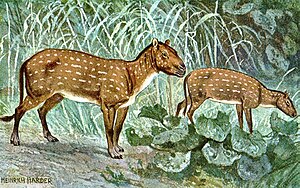Hyracotherium
| Hyracotherium | ||||||||||||
|---|---|---|---|---|---|---|---|---|---|---|---|---|

Hyracotherium , depiction by Heinrich Harder (ca.1920) |
||||||||||||
| Temporal occurrence | ||||||||||||
| Eocene ( Ypresian ) | ||||||||||||
| 55.4 to 48.6 million years | ||||||||||||
| Locations | ||||||||||||
| Systematics | ||||||||||||
|
||||||||||||
| Scientific name | ||||||||||||
| Hyracotherium | ||||||||||||
| Owen , 1841 | ||||||||||||
Hyracotherium is an extinct genus of the odd ungulate from the Paleogene (about 55.8 to about 48.6 mya ) of Eurasia and North America . The genus belongs to the ancestral group of horses and is considered one of the earliest known representatives of the horse relatives (Hippomorpha or Equoidea).
features

The animal had a shoulder height of about 20 centimeters. That made it about the size of a fox. The back was arched, the neck relatively short. In contrast to today's horses, it had four toes on the front legs and three toes on the hind legs. The molars were low-crowned and therefore adapted to soft plant food such as leaves. It is believed that Hyracotherium was an inhabitant of swampy forests and lived in groups. Fossil finds from the early Eocene ( Ypresian ) are known from Europe , North America and Asia .
designation
The British anatomist and paleontologist Richard Owen in 1841 published the first description of Hyracotherium ( " Hyrax - (= Hyrax ) -like animal") on the basis of an incomplete discovery from England. In 1876, the American paleontologist Othniel Charles Marsh published a description of a complete fossil from North America, which he named Eohippus ( Greek for "horse of the dawn") after Eos , the goddess of the dawn from Greek mythology. In 1932, Clive Forster Cooper noted that both genera, the European Hyracotherium and the North American Eohippus , were the same taxon , whereupon the latter was given the name of the older synonym according to the priority rule . However, Eohippus was declared valid again in 2002 by David J. Froehlich in the course of the dissolution of the North American strain of Hyracotherium into different genera such as Sifrhippus , Minihippus or Xenicohippus , all of which belong to the evolutionary line of the Equidae .
Systematics
The systematic position of Hyracotherium is still controversial. In the past it was considered to be the oldest representative of the horses (Equidae), today it is more inclined to classify it in the Palaeotheriidae , a family that died out in the Oligocene and which form the group of equine relatives (Hippomorpha or Equoidea) with the horses. Sometimes it is also classified as a basic (original) representative of the horse relatives.
literature
- Thomas S. Kemp: The Origin & Evolution of Mammals. Oxford University Press, Oxford 2005. ISBN 0-19-850761-5 .
Individual evidence
- ^ The Paleobiology Database . Last accessed on February 24, 2011
- ↑ Bruce J. MacFadden: Fossil Horses. Systematic, Paleobiology, and Evolution of the family Equidae. Cambridge University Press, 1992 (p. 90)
- ↑ David J. Froehlich: Quo vadis eohippus? The systematics and taxonomy of the early Eocene equids (Perissodactyla). Zoological Journal of the Linnean Society, 134, 2002, pp. 141-256
